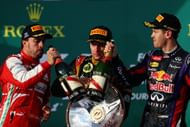
The Big Three: Midfield teams can’t afford the likes of Kimi Raikkonen (C) of Lotus, Fernando Alonso (L) of Ferrari and Sebastian Vettel (R) of Red Bull. (Getty Images)
Changes to the regulations
The FIA has taken some steps to prevent factory teams running away at the front next year. Some of the very important changes are restrictions imposed on Wind Tunnel and CFD testing. According to the rules,
WT <= WT_limit (1 – CFD/CFD_limit)
Where:WT = Wind On TimeWT_limit = 30 hoursCFD = CFD Teraflops UsageCFD_limit = 30 Teraflops
How much of a benefit will this be in bridging the gap can’t be predicted at the moment but definitely it will limit the Big Four to some extent. Even then it’s good to see that the FIA are taking some steps to bring equality and as time passes we might see even more restrictions as the governing body tries to strike a fine balance between creating a level playing field and continue the aim of being more relevant towards the auto industry.
Selecting drivers purely on merit
A very long shot no doubt. Many would agree that one reason that the midfield teams are not able to regularly mix it up with the front is that they don’t have the best drivers. The reason for that is they simply can’t afford the likes Fernando Alonso, Kimi Raikkonen, Lewis Hamilton and Sebastian Vettel.
Williams’ newly-appointed Chief Technical Officer Pat Symonds recently said that the Marussia pair is, on average, half a second slower than the considered best in the business Alonso, and that is on normal tracks – circuits like Monaco and Singapore will make that gap close to a second probably. Obviously it won’t make a difference for a team like Marussia which is around three or four seconds slower on average but for a team like Force India, which is lacking somewhere around that half a second mark, a driver like Alonso could have made all the difference.
To solve this problem, what needs to be done is drastically reduce the role money plays in deciding which driver makes his foray into Formula 1. That will automatically benefit both the driver as well as the engineer with constructive feedback from both sides and that ultimately showing its effect on the development curve of the car.
Will this mission be successful?
If even any one of the above materialises then we can be sure that the sport is going to be safe in the near future. The unfortunate part is that no single party or individual can be blamed for the current state and that makes the reconstruction process even more difficult.
It might become close to impossible if Bernie Ecclestone is put behind bars as he has been the centre of all major happenings in the sport since the 70′s but we shouldn’t lose hope because the sport has come out of even worse situations in the past. Formula 1 was, is and hopefully will remain as the pinnacle of motorsport.
